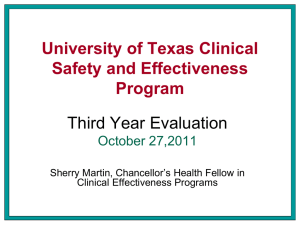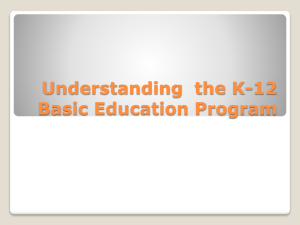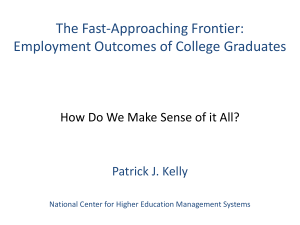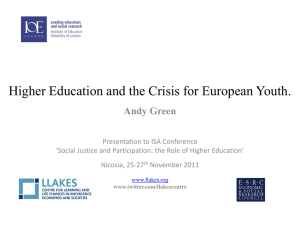The Nonfinancial Benefits of Higher Education for Individuals and
advertisement
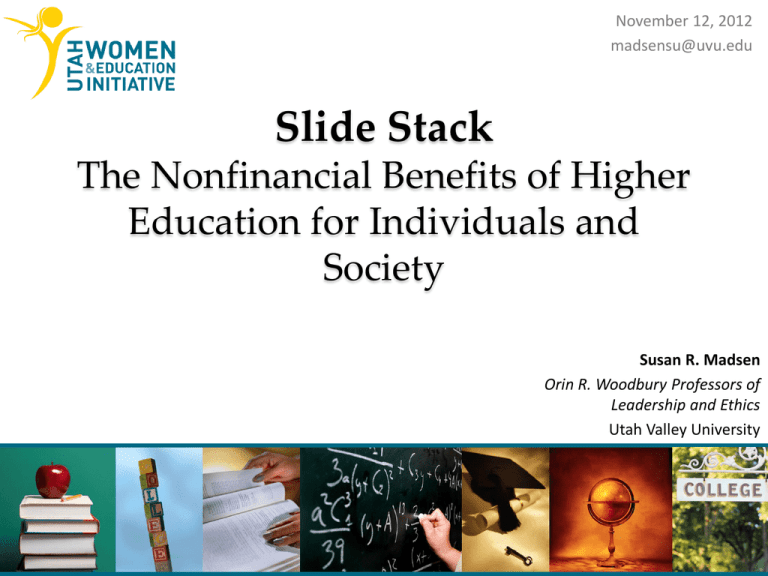
November 12, 2012 madsensu@uvu.edu Slide Stack The Nonfinancial Benefits of Higher Education for Individuals and Society Susan R. Madsen Orin R. Woodbury Professors of Leadership and Ethics Utah Valley University Outline 1. Health and Well-being a. b. c. d. Smoking Exercise Obesity Low Birth Weight and Breast-Feeding 2. Civic and Community Engagement a. Volunteerism b. Voting 3. 4. 5. 6. Parenting Self-Development Intellectual and Cognitive Development Other Societal Benefits 1 Health & Wellbeing • Live longer lives (on average) • Have an overall healthier lifestyle (exercise more, healthier diet, lower alcohol abuse, lower cholesterol levels, higher fiber intake, smoke less) • Are less overweight or obese Health & Wellbeing • Have increased life satisfaction and overall happiness • Are more resilient and less depressed (better mental health) • Acquire more resources to pay for health insurance Smoking • Smoking rates among college graduates have been significantly lower than smoking rates among other adults since information about the risks became public. • College graduates were at least as likely as others to smoke before the medical consensus on the dangers of smoking became clear. • Smoking rate of college graduates had the largest drop in all categories. Source: Education Pays 2010 Smoking Rates Obesity & Exercise • Within each age group, collegeeducated adults are less likely than others to be obese. • Children living in households with more highly educated adults are less likely than other children to be obese. • At every age, individuals with higher levels of education are more likely than those with lower levels of education to engage in leisure-time exercise. Obesity and Education Source: Goals for the Common Good Obesity Rates Obesity Among Children/Youth Exercise Rates Low Birth Weight and Breast-Feeding • Mothers with higher levels of education are less likely than others to have low-birth-weight babies and are more likely than others to breast-feed their babies. • Overall, mothers with only a high school education are 31% more likely than mothers with a bachelor’s degree or higher (8.9% vs. 6.8%) to give birth to babies weighing less than 5.5 pounds. Source: Education Pays 2010 2 Civic and Community Engagement • Participate substantially more in civic and community activities o Voting o Donating blood o Filling leadership roles • Be a more conscientious civic and community volunteer Volunteerism • The percentage of people who donate their time to organizations and the number of hours people spend in volunteer activities are higher among individuals with higher levels of education. • College graduates are more likely to donate blood (National Health Interview Survey). • Higher levels of education provide students opportunities to apply what they have learned in non-profit organizations and other community settings (service-learning, internships). Volunteering Rates Voting • In every age group, adults with higher levels of education were more likely to vote than those with lower levels of education. • Among individuals ages 25 to 44, there was a 32 percentage point gap between the voting rates of four-year college graduates and high school graduates. • The voting rate gap for individuals ages 18 to 24 was 30 percentage points. Voting Rates Source: Goals for the Common Good 3 Parenting • • • • Give birth to healthier babies Spend more time reading to their children Prepare children better academically for school Have children who participate in extracurricular activities Parenting • Provide healthier lifestyles for their children • Work higher paying, more flexible jobs • Have more collegeeducated children who can better provide for self and families Parenting • Children of parents with higher levels of educational attainment are better prepared for school and, while in school, are more likely than other children to engage in educational activities with their parents. • Children between the ages of 3 and 5 whose parents had bachelor’s degrees were more than twice as likely as children of high school graduates to recognize all of the letters of the alphabet (39% vs. 18%). Parents and Children • Children whose parents had some college but no degree were 50% more likely than children of high school graduates to recognize all of the letters of the alphabet (27% vs. 18%). • Among parents whose highest degree was a bachelor’s degree, 68% read to their children daily. This compares to 57% of parents with an associate degree, 47% of parents with some college but no degree, 41% of high school graduates, and 26% of parents who did not complete high school. Parents and Children Parents with higher levels of education more frequently participate with their school-age children in a wide variety of activities, ranging from going to a library to participating in community/religious /ethnic activities, to attending concerts or other live events. Reading Proficiency Source: Goals for the Common Good Benefits to a Reading Citizenry Source: Goals for the Common Good 4 Self-Development • Improved selfunderstanding • Greater independence and feelings of control in life • Superior leadership skills • Higher ethical and moral standards and reasoning Self-Development • • • • • Stronger social skills Better self-concept/self-esteem Openness to diversity and racial understanding Greater ability to make reasoned, reflective judgments Stimulating occupations and increased quality of life 5 Intellectual/Cognitive • Better lifelong learning skills • More intelligence/knowledge (e.g., English, science, math, social sciences, reading) • Stronger teamwork and interpersonal skills Intellectual/Cognitive • Increased ability to integrate ideas and concepts • Stronger written and verbal skills • Higher critical and creative thinking, as well as decision making skills • Enhanced quantitative and analytical skills 6 Other Societal Benefits • Societies that have higher levels of education are safer; more educated individuals are less prone to commit criminal behavior. • For every year of increase in the average schooling level within a community, there is a 30 percent decrease in murder. • Communities that have a well-educated citizenry have fewer incidences of depression and suicide. Incarceration Rates Source: Goals for the Common Good Poverty Rates • The 4% poverty rate for bachelor’s degree recipients was one-third of the 12% poverty rate for high school graduates. • The poverty rate for all associate degree recipients was 7%, compared to 9% for individuals with some college but no degree. • The 12% poverty rate for bachelor’s degree recipients living in families headed by unmarried females was about one-third of the 35% poverty rate for high school graduates living in similar families. Households in Poverty Public Assistance • The percentage of high school graduates ages 25 and older living in households qualified for and receiving Medicaid was three times as high as the percentage of those with a bachelor’s degree or higher participating in this program. • In 2008, 8% of high school graduates ages 25 and older lived in households that relied on the Food Stamp Program, compared to just over 1% of those with at least a bachelor’s degree. The pattern was similar for the National School Lunch Program. Source: Education Pays 2010 Public Assistance Programs References • American Human Development Project. (2009). Goals for the common good: Exploring the impact of education. Retrieved from http://www.measureofamerica.org/file/common_good_forecaster_ full_report.pdf • Association of American Colleges and Universities. (2005). Liberal education outcomes: A preliminary report on student achievement in college. Retrieved from http://www.aacu.org/advocacy/pdfs/LEAP_Report_FINAL.pdf • Baum, S., Ma, J., & Payea, K. (2010). Education pays: The benefits of higher education for individuals and society (Trends in Higher Education Series, Report No. 7). Retrieved from http://trends.collegeboard.org/sites/default/files/education-pays2010-full-report.pdf • Pascarella, E. T., & Terenzini, P. T. (2005). How college affects students: A third decade of research. San Francisco: Jossey-Bass.



